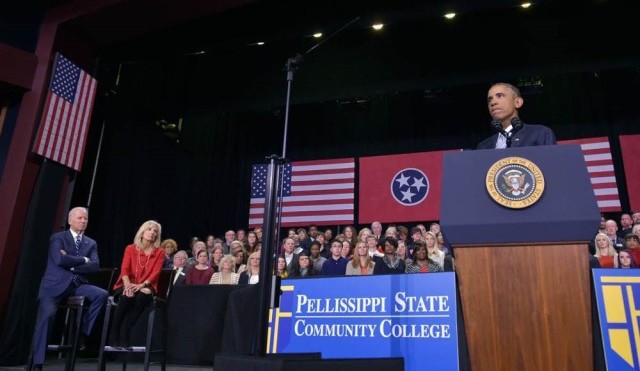As noted in my last post, outgoing Secretary of Education Arne Duncan has done his part to transform America through K-12 education. This has happened through Common Core and by expanding the Department’s reach into younger and older cohorts. Duncan got the promise for an additional $1 billion for preschool education. As the Chronicle of Higher Education noted, Duncan is also leaving a “big imprint” on higher education. His legacy is one of “innovation and regulation.” College is put into a seamless web of K-16, or P-20, with an unprecedented federal role in admissions, placement, assessment, and financing.
The Chronicle notes that Duncan has deviated from the standard practice of Democratic secretaries who have just doled out money. He has been “personally upbraid[ing] colleges over rising prices and low graduation rates, their handling of cases of sexual assault, their lax academic standards for athletes . . . , and their resistance to greater oversight.” Patricia McGuire, president of Trinity Washington University, has become disillusioned with Duncan’s “top-down approach.” Institutions, like Yale University, get nervous about the Department’s investigations of “sexually hostile environments.”
The nonprofits, like the Lumina Foundation, that have been funding Common Core, however, give a positive assessment. Jamie Merisotis, President and Chief Executive, praises Duncan’s “strong leadership” in putting our higher-education system “a step closer to reflecting the needs of today’s increasingly diverse college students — and the changing meaning of ‘college’ to include all types of postsecondary learning.” Competency-based programs that “measure learning” through demonstration of a skill set are among his many “innovations.” Inside Higher Education calls it “new delivery model with the potential to improve degree completion, reduce costs to students, and improve transparency and alignment of learning outcomes to the needs of employers and society.”
Currently, over 600 colleges are designing, creating, or already have competency-based education programs. This number has grown from 52 last year. As with Common Core, it is being funded by the Bill and Melinda Gates Foundation, with “guidance” from the U.S. Department of Education.
The notion of “competency” changes the fundamental notion of education, taking it from learning for its own sake, with a knowledgeable, independent citizenry as an outcome, to producing workers with skill sets. Colleges that have agreed to align financial aid to such tests have ceded their own power.
Funny, Arne Duncan, when he spoke at the 2013 meeting of the American Education Research Association (AERA) and promised a “sea-change” in assessments for K-12 students, included “competency-based education,” as well as “non-cognitive skills.” Others at that AERA meeting of academics and researchers working at universities, federal and state agencies, school systems, test companies, and non-profit agencies were Linda Darling-Hammond, who oversaw the development of the SBAC (Smarter Balanced Assessment Consortium) tests, one of the two Common Core tests, and her close colleague, Bill Ayers.
Many colleges are following the Department of Education in emphasizing non-cognitive, “social and emotional learning” skills. Seventeen colleges have received funds from the Department’s “First in the World” grants to identify and help at-risk students through the aid of a tool called Diagnostic Assessment and Achievement of College Skills to measure such emotional attributes as “grit.”
Colleges have been targeted strategically. Jacqueline King, director of Higher Collaboration at SBAC, has been working to “create greater academic alignment between K-12 and higher education.” Common Core tests are determining placement in college courses. In 2014, college faculty in Tennessee attended workshops to learn how to “synch up with Common Core,” in effect to teach grade 13.
I reported that the Department of Education had funded the 2013 working paper, “The Common Core State Standards: Implications for Community Colleges and Student Preparedness for College.” It described the “Core to College” program in ten states: Colorado, Florida, Hawaii, Indiana, Kentucky, Louisiana, Massachusetts, North Carolina, Oregon, and Washington. Core to College is funded by the Lumina, the William and Flora Hewlett, the Bill and Melinda Gates, and other foundations. Their report, “Making Good on the College-Ready Promise and Higher Education Engagement Core to College Alignment Director Convening, August 1-2, 2012,” provides a record of discussions by “alignment directors” and guest speakers on teaching “a new type of student, more prepared for college-level, discipline-specific work.” (As a former college instructor I am skeptical: having “more prepared” students meant an easier time in teaching them—not the need for special workshops.)
The ten states are to serve as “bellwethers and models for the rest of the country.” Among the strategies, directors suggested more data, outreach to other “stakeholders” and private colleges, and more meetings. They are also looking beyond “the English and Math Departments” that receive Common Core-certified students. Speakers proposed “engaging faculty in other disciplines that could be touched by Common Core implementation, such as history or the social sciences.”
WestEd, a major Common Core funder, is evaluating the initiative.
The push for new assessments (especially at community colleges) has been quickly followed by calls for free community college. In his 2014 State of the Union address, President Obama cited Tennessee’s still-developing program as a model. The American Association of Community Colleges welcomed the proposal. This year, on September 9, Obama announced that the “College Promise Campaign” would be chaired by Second Lady Jill Biden. AACC President Walter Bumphus and Trustee President J. Noah Brown will serve on the National Advisory Board.
Democratic front-runners, Hillary Clinton and Bernie Sanders, pushed free college in their first presidential debate on October 13, 2015.
To top it off, the federal government is providing a college “scorecard.” Of course, those who continue to refuse federal aid, like Grove City College and Hillsdale College, will continue to be left off.
Students at these colleges will also find themselves at an increasing financial disadvantage. One of Obama’s first orders of business was to make the federal government the bank for student loans. This “bank” practices “loan forgiveness,” by graduating payment to income and providing complete forgiveness through work in government jobs, such as in public schools or at Americorps, the federal agency. Indiana University law professor Sheila Seuss Kennedy and Indianapolis Chamber of Commerce manager Matt Impink enthused about such a “tour of duty” that sounds like the “civilian corps” Obama put forth at the beginning of his presidency.
We are well on our way. With schools producing graduates with competencies “align[ed] to the needs of employers and society,” and with Common Core spitting out high school graduates “college and career ready,” we will no longer worry about higher learning.
EDITORS NOTE: This column originally appeared on the Selous Foundation for Public Policy Research website. The featured image is of President Obama announcing free community college with Vice President Joe Biden and Second Lady Jill Biden.











 ABOUT DR. KAREN WALBY
ABOUT DR. KAREN WALBY





 They demanded he drop out of the race. They’re a 501c3 organization, and such organizations are not supposed to intervene in campaigns either on behalf of or in opposition to a candidate. Clearly the gang of thugs at Hamas-linked CAIR, designated a terror organization by the United Arab Emirates, is in violation of the law here, but it is almost certain that Obama’s politicized Justice Department will take no action.
They demanded he drop out of the race. They’re a 501c3 organization, and such organizations are not supposed to intervene in campaigns either on behalf of or in opposition to a candidate. Clearly the gang of thugs at Hamas-linked CAIR, designated a terror organization by the United Arab Emirates, is in violation of the law here, but it is almost certain that Obama’s politicized Justice Department will take no action.




